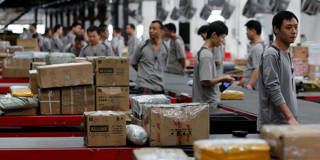In recent years, as China’s economy has become increasingly reliant on high-tech and modern service industries, jobs and growth have become concentrated in a few high-productivity cities. In fact, it is this inter-urban competition that has driven China’s economic transformation.
SHANGHAI – China’s traditional industries are suffering. In the last five years, the country’s northeastern region – once a hub of basic industries like oil and steel – has been facing accelerating decline, as have the rich mineral resource centers in places like Hebei and Inner Mongolia. Over the last decade, about one-third of China’s 600 cities have contracted. The prospects of dispersed rural populations far away from China’s megacities have diminished as well. But all this bad news is actually a result of what is widely considered very good news: China’s economic transformation is progressing.
In recent years, China’s economy has becoming increasingly reliant on new high-tech and modern service industries, including mobile Internet, artificial intelligence, smart cars, drones, robots, virtual reality, wearable device manufacturing, green technology, and more. Meanwhile, jobs and growth have become increasingly concentrated in some high-productivity megacities, making them magnets for skilled labor and venture capital – and leaving hubs of traditional industries in the dust.
The rapid growth in China’s high-tech industries was thrown into sharp relief earlier this month at the annual Consumer Electronics Show (CES) in Las Vegas, Nevada, where Chinese firms accounted for 40% of all exhibitors – a figure that would have been unthinkable just five years ago. Many of those firms are from Shenzhen, China’s first special economic zone and now the country’s most innovative city.

SHANGHAI – China’s traditional industries are suffering. In the last five years, the country’s northeastern region – once a hub of basic industries like oil and steel – has been facing accelerating decline, as have the rich mineral resource centers in places like Hebei and Inner Mongolia. Over the last decade, about one-third of China’s 600 cities have contracted. The prospects of dispersed rural populations far away from China’s megacities have diminished as well. But all this bad news is actually a result of what is widely considered very good news: China’s economic transformation is progressing.
In recent years, China’s economy has becoming increasingly reliant on new high-tech and modern service industries, including mobile Internet, artificial intelligence, smart cars, drones, robots, virtual reality, wearable device manufacturing, green technology, and more. Meanwhile, jobs and growth have become increasingly concentrated in some high-productivity megacities, making them magnets for skilled labor and venture capital – and leaving hubs of traditional industries in the dust.
The rapid growth in China’s high-tech industries was thrown into sharp relief earlier this month at the annual Consumer Electronics Show (CES) in Las Vegas, Nevada, where Chinese firms accounted for 40% of all exhibitors – a figure that would have been unthinkable just five years ago. Many of those firms are from Shenzhen, China’s first special economic zone and now the country’s most innovative city.